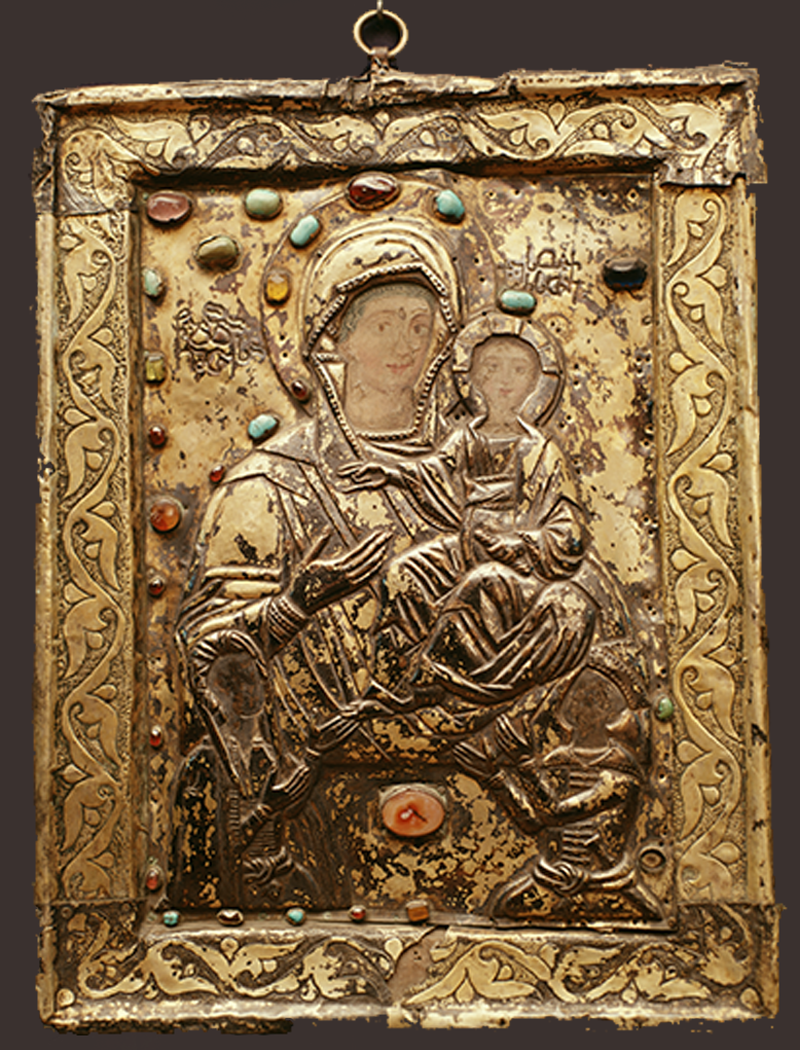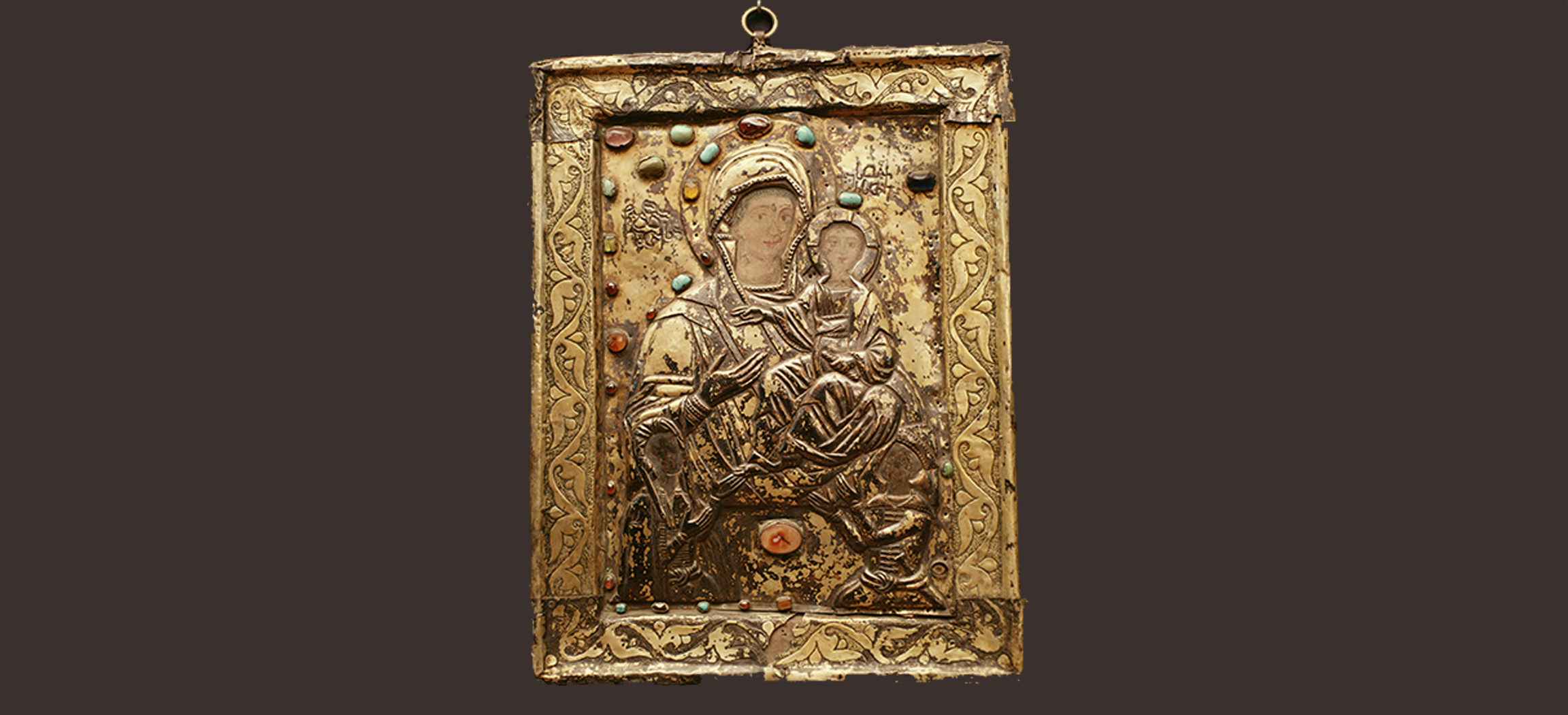
Feel free to add tags, names, dates or anything you are looking for


In the history of Georgian repoussé art, the 17th century represents a significant period, marked by the establishment of a goldsmith's workshop amid the challenges and upheavals of the era. The workshop, founded by the prominent Prince of Odishi (Samegrelo), Levan Dadiani, a distinguished figure of the time, has garnered considerable interest. To what extent did the strained family relations within the Dadiani family affect the works produced in this workshop? It is worth recalling how he treated his first wife, the daughter of Sharvashidze. Without apparent reason, he accused her of betrayal, having fallen in love with Nestan-Darejani, the beautiful wife of his uncle, Giorgi Lipartiani. Subsequently, he abducted his aunt and married her.
In an attempt to atone for his actions, Dadiani commissioned the creation of a significant number of icons. Furthermore, he sought to immortalize Nestan-Darejani by having her likeness inscribed on numerous icons alongside his own. The prince’s ambition led to the creation of numerous icons and portraits, as well as the establishment of the aforementioned workshop. His attitude toward culture is reflected in his stewardship of the workshop and his patronage of artists across various disciplines.
Italian missionary Lambert notes that the workshop at Levan Dadiani's court operated for a decade, employing over twenty goldsmiths. The sheer volume of works produced during Levan's reign is so significant that they serve as a comprehensive research resource for 17th-century repoussé art. All of these works were personally commissioned by Levan Dadiani. The Dadiani works span a period of forty years (1619–1659). Despite the abundance of material, no clear evolution or stylistic changes can be observed. The works can be divided into two groups: a smaller group from the early years of Levan Dadiani’s reign and a larger, more varied group that showcases a higher level of craftsmanship. The artistic solutions in the Dadiani icons reflect the broader trends that define this era. The style is eclectic, incorporating various techniques and styles within a single piece. Additionally, the Dadiani icons feature lengthy inscriptions in Mkhedruli script, providing valuable insight into Georgia’s political landscape during that period. Some of the works include references to the geographical locations where Levan Dadiani built palaces. Other inscriptions mention Dadiani’s workshop, providing additional historical context. These inscriptions list the names of the goldsmiths who created the works. Of particular interest is the autograph accompanying some of these inscriptions, which Dadiani used to immortalize his name.
_ტაბ._1,__წარწერა_ოქონის_ხატის_ბუდეზე_Large.png)
Inscription on the Cover of the Okoni Icon: Levan Dadiani’s Autograph
Six icons created at the prince’s request serve the same purpose: to depict his image.
_ტაბ._2,_2.1_კორცხელის_წინასწარმეტყველთა_ხატი_Large.png)
An image of Levan Dadiani and Nestan-Darejani on the Kortskheli Prophets’ Icon
The creation of multiple portraits of a single individual is a unique occurrence in the history of Georgian repoussé art. Moreover, it is rare to find a scene depicting an entire family within this tradition. However, one of Dadiani’s icons features just such a scene, depicting Levan Dadiani, his wife Nestan-Darejani, and their sons Alexander, Manuchar, and Zilimkhan. The use of ktitors in the Dadiani icons likely reflects the emergence of secular elements, which may indicate a growing inclination toward realism during the late feudal era. The dominant social classes adopted emerging trends, incorporating Iranian fashion into their aesthetic sensibilities. High-ranking officials, who set the trends, sought to emulate the appearance, names, and even the colloquial speech of the Persians. This was the goal set for those responsible for art. The garments worn by the figures depicted in the Dadiani icons are reminiscent of Persian attire, as are their kneeling postures, gesticulations, hairstyles, and crowns adorned with gems and jewels.
_სქემა_3_ჩაცმა-დახურვის_წესი_Large.png)
The Style of the Dadiani Garments
However, it seems that the Dadiani goldsmiths regarded Iranian fashion as a shallow influence, striving to preserve indigenous Georgian traditions by incorporating local embellishments into their creations. The decorative repertoire is vast and diverse, serving as a key distinguishing factor between these works and other 17th-century art. The ornamentation of the Dadiani icons blends traditional and contemporary motifs. The vine leaves, depicted in concentric circles and intertwined, have a long-standing tradition, as does the cuneiform pattern. The trident-shaped leaf, following the stem's curve, is also a well-established design.
_სქემა_1.2_დადიანისეული_ხატების_ორნამენტი,_1_Large.png)
Ornamentation in the Dadiani Icons
_სქემა_1.2_დადიანისეული_ხატების_ორნამენტი,_სურ._1_Large.png)
Ornamentation in the Dadiani Icons
The leafy motif in the Dadiani icons is particularly diverse, with many of its variations being unique. The Tsarche Archangel icon features a finely crafted floral design, depicted as a blooming leaf, subtly raised against a perforated background. The leaves along the stem are rendered realistically, presenting them in a novel manner.
,_ტაბ._2,_2.5_წარჩეს_მთავარანგელოზთა_ხატი_Large.png)
Tsarche Icon of the Archangels
A common stem is used to arrange the leaves on the frame of the icon of St. George of Sujuni.
The Dadiani icons are also adorned with gemstones, including pearls, turquoise, ruby, and occasionally sardonyx. Beyond their aesthetic appeal, this ornamentation seems to symbolize repentance or atonement for misdeeds.
From an iconographic perspective, the Dadiani icons stand out. The Dadiani goldsmiths selected unconventional and novel subjects for their works. The resurgence of traditional iconographic narratives can be attributed to the stagnation in the evolution of Georgian repoussé art, which led goldsmiths to focus solely on content. The Kortskheli prophets' icon and the Ilori icon are notable for their rich symbolism and entirely original plots, as evidenced by their iconographic themes.
,_ტაბ._2,_2.3_ილორის_ხარის_მოყვანის_სახის_ხატი._Large.png)
Ilori icon
Another 16th-century icon from Ilori presents a similar narrative. An icon with such content is unparalleled, thereby suggesting its local origin.
The unique iconographic motifs in the Ilori icon of the Miracles of St. George, dated 1651, no longer exist today. The depiction of the youth’s liberation from captivity is rare in medieval art, and the Miracle of St. George ingesting poison, along with the death of the poisoner, is absent from Georgian literary sources. It is believed to be derived from folklore and influenced, to some extent, by Western art. The court of Levan Dadiani held Italian missionaries in high regard, and the Miracle of St. George, along with the legend of reviving the bull, are relatively uncommon in Georgian iconography, appearing in only a few monuments. The 1656 icon of John the Baptist reflects the influence of Russian iconographic schemes, as evidenced by its depiction of a figure in a mourning robe with two fingers of the right hand pointing to the Messiah. Given these observations, the Dadiani icons, with their iconographic innovations, present a compelling subject for further study.
Another notable feature of these icons is the depiction of faces painted on metal.
Levan Dadiani’s goldsmith workshop, which produced numerous 17th-century repoussé artworks, holds significant historical importance within this field. Although it could not prevent the decline of repoussé during that period, it nonetheless preserved essential national traditions that had developed over centuries. This legacy enables us to engage in meaningful discussions about Georgian repoussé art and its achievements.
G. Chubinashvili National Research Centre for Georgian Art History and Heritage Preservation